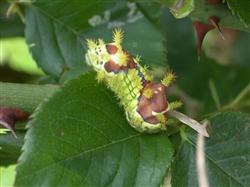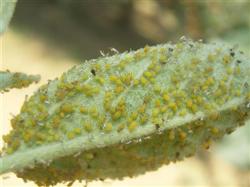transparent wing Learn more about transparent wing
-
How to identify pear bugs

(1)Pear net bug: ① adult: body length about 3.5 mm, flat, dark brown. Small head, broad wings, dark black compound eyes, no monocular. Proterodorsal plate raised on both sides of the wing-like, translucent, which have network patterns. The front wings are slightly rectangular, and two are at rest.
2020-11-08 species pear tree how identification bug pear net ① -
Sycamore planthopper

The morphological adult is 5.6 to 6.9 mm long, yellowish green, transverse width of the head, deeply parted top, forehead exposed, compound eye hemispherical protruding, brown antennae yellow, wings colorless and transparent, wing veins yellow, claws black; yellowish belly back, brown ribbon in front of each node. Egg spindle-shaped, 0.5 to 0.8 mm long, slightly transparent, yellowish or yellowish brown at birth, reddish brown before hatching. When the nymphs are newly hatched, they are oblong, 3.0 to 5.0 mm long and dark in color, and the wing buds are obviously visible.
2019-01-15 -
Grape planting should be controlled in due time

In recent years, grape transparent moth occurred in many vineyards and courtyards in Xuzhou, mainly damaging grape branches and vines, resulting in yield reduction or even whole plant death. Grape transparent wing moth larvae damage grape tender shoots and 1-2 years old branches, the first instar larvae eat into the tender shoots, eat the pith, so that
2020-11-08 species grape want timely control transparent wing moth recent years -
Crystal Family in succulent plants

Text: today, the curator of Le'an brought you to enjoy the crystal family in the succulent plant. How many kinds do you know? 1, round head jade dew, the plant is exquisite and small, the window at the top of the leaf is glittering and translucent, fleshy.
2018-07-11 -
Privet inchworm

Scientific name: NaxaseriariaMotschulsky morphological characteristics: adult wing spread about 40 mm, slender body, yellow-white. The front and rear wings are thin, white and slightly transparent, with two rows of black stellate spots on the outer edge and a large black spot in each wing. The front wing also has a row of black and brown spots near the base angle. The eggs were white at first, then gradually changed to orange-red, shiny and arranged in the shape of beads. The larvae are about 30 mm long, dark brown, with inconspicuous black patterns and spots. Except for the chest foot and the eighth and ninth abdominal feet,
2019-01-16 -
Ganoderma lucidum pest: White ants

White ants (CoptotermesformiosanusShiraki) are alias termites and house termites. Belonging to the class Insecta, Isoptera. 1. Morphology and habits there are three forms and different functional types of termites in each nest group. Large-winged ants (breeding ants), also known as flying ants, body length 7.5-8.5 mm, wing length 11 mm, head nearly round, brown, secretory hole is not obvious, antennae 21 nodes. Yellowish brown in chest and abdomen. The wings are gray-white and transparent, and the wings and leading edges are yellowish brown. Soldier ant body
2019-01-16 -
What is the Chinese rose leafhopper?

How to control Spodoptera litura? Please guide the rose yellow moth: morphological features: adults orange-yellow, antennae filamentous brown diagonal, converging at the tip of the wing. It is inverted v-shaped, the hind wings are grayish yellow, the feet are brown, the eggs are flat and oval, yellowish. The larva is slightly rectangular, the front end is slightly larger, and the body color.
2018-07-18 -
What are the characteristics of black locust aphid? What is the method of prevention and control?

Robinia pseudoacacia aphid harms many kinds of legumes, such as Robinia pseudoacacia, locust tree, Amorpha fruticosa and so on. As an adult. The new shoots of Robinia pseudoacacia are clustered by nymphs to suck sap, which causes the new shoots to bend, the young leaves curl, the branches can not grow, and its secretions often cause coal fouling disease. The wingless aphid is about 2 mm long, oval, black and glossy, with obvious hexagonal reticulation on the back of the head, chest and abdominal segments 1-6; horizontal striations on the abdominal segments 7 and 8; winged aphids, long ovoid, black and smooth, wings gray-white, transparent. Robinia pseudoacacia aphids occur for more than 20 generations a year. Mainly with
2019-01-15 -
What are the pests of camellias to be controlled?

What are the pests of camellias to be controlled? Please give a detailed introduction to the following pests of camellias: aphids [morphology and harm] aphids are divided into winged aphids and wingless aphids. Winged viviparous female aphid, transparent wings, dark brown body; wingless viviparous female aphid, wingless, dark brown body. In addition, if early appearance and adults.
2018-07-18 -
The wings of the earth, an amazingly beautiful plant.

Earth wings, English name Daggerpod, alias Cardamine cicadae, is a perennial succulent herb. It is small, rosette leaves, gray-green, soft, fleshy hairy, and has dense inflorescences of small white flowers, fruit 2 to 3 cm, oval.
2018-05-13 -
What are the characteristics of Xiaofeng of Robinia pseudoacacia seeds? What is the method of prevention and control?

Robinia pseudoacacia seed wasps mainly harm Robinia pseudoacacia. The larvae feed on the seeds in the pods. Adult, about 3 mm long, black, yellowish brown antennae, raised chest, transparent wings, short thorns in cloth, simple wing veins, yellowish. Ovate, fusiform, with long slender stalks at one end. Larva, the last instar body is about 4 mm long, milky white, the head is inconspicuous, the upper jaw is brown, the body is curved. Robinia pseudoacacia seed wasps produce two generations a year. Overwintering as larvae in seeds. In the coming year, it usually pupates from April to May, and adults appear and lay eggs after the first and middle of May.
2019-01-15 -
Species of crabapple flowers and culture methods of crabapple flowers

Species of crabapple flowers and culture methods of crabapple flowers
2019-03-06 -
Occurrence and Prevention of Common Diseases of Pleurotus ostreatus

In recent years, with the expansion of Pleurotus ostreatus cultivation area and the increase of cultivation years, the damage of pests is becoming more and more common, and the trend of occurrence is early and fast, and there is no harvest in serious cases. Because Pleurotus ostreatus is sensitive to pesticides and easy to produce drug damage, it is difficult to achieve the effect of killing insects and protecting mushrooms when the pests occur. Therefore, identifying the damage characteristics of various pests and reducing the source of infection are effective measures to avoid and reduce the occurrence of insect pests. Species of pests 1. Eye bacteria mosquitoes are also known as sharp-eyed bacteria mosquitoes, commonly known as small black mosquitoes, small flies, white maggots (refers to larvae). Diptera, mosquitoes
2019-01-16 -
Tanbi (Peach Blossom Tanbi) Chunlan

In 2007, he went down the mountain in Taohuatan Town, Jing County, Anhui Province, that is, Wang Lun bid farewell to Li Bai. The gentleman's country peeled off flowers in the mountains to buy, named Peach Blossom Tanbi, referred to as Tanbi, as a souvenir. This kind of thick waxy oil is bright and strong, the flowers are big, green and handsome, and the pole is high. He thinks that he is far above the old kind of Wang Xiaochun. This flower floats with five petals.
2018-02-26 -
Growth process of Silkworm, Bombyx mori

Growth process of Silkworm, Bombyx mori
2018-09-08 -
Control of peach moth

Peach borer also known as peach borer, peach borer, peach borer and so on. Belongs to lepidoptera, moth family. 1. Morphological characteristics: adult body length about 12 mm, wing spread 22~25 mm, orange yellow, front wing has more than 20 black spots, after wing more than 10. The eggs are oval, milky white at the beginning, and turn reddish brown before hatching. Larvae body length 22 mm, dark brown head and neck, pale red back, body sections have several pale brown spots. Pupa length of about 13 mm, brown, abdominal end has 6 curly buttocks thorn.
2019-01-16 -
Rice leafhopper with white wings

The scientific name ThaiarebiginosaKuoh was mistaken for Eryfhroneurasubrufa (Motsulsky) belonging to Homoptera, Cicadellidae. It is distributed to the south of the Yellow River and east of Xichang, Sichuan. Yunnan, Guizhou, some mountainous areas of Sichuan and Hanzhong of Shaanxi suffered heavily. Host rice, wheat, barley, sugarcane, English white, corn, rape and so on. With the characteristics of damage, the nymphs sucked the sap of the leaves, and the damaged leaves appeared sporadic white spots at first, and then connected into dotted stripes, or white stripes were the most.
2019-01-16 -
Morphological characteristics of Rice Root and Leaf Beetle and its Control techniques

Rice root leaf beetle, also known as rice root golden flower worm, belongs to Coleoptera, Chrysomelidae. The adult is about 6 mm long, with greenish brown and metallic luster on the back and antennae, and dense silver hairs on the ventral side. The lower part of each leg segment was enlarged, and there was a dentate thorn at the proximal end of the posterior leg segment. There are several parallel longitudinal grooves composed of engraving points on the sheath wing. The eggs are laid in blocks and covered with a white transparent gel. The egg is long oval, slightly flattened, about 0.8 mm long, colostrum white, and then becomes yellowish. The larva is about 9 mm long, spindle-shaped, white slightly curved, with 3 pairs of chest feet.
2019-01-16 -
High-yield cultivation techniques of Chinese nutgall

High-yield cultivation techniques of Chinese nutgall
2018-06-29 -
Pests and control methods of rhododendron

The main pests of rhododendron are red spider, rhododendron net bug and aphid. Red spiders can be controlled by pruning or avermectin spraying; rhododendron bugs can be controlled by removing diseased leaves or spraying imidacloprid; aphids can be controlled by washing, armyworm board or spraying imidacloprid.
2018-07-11
